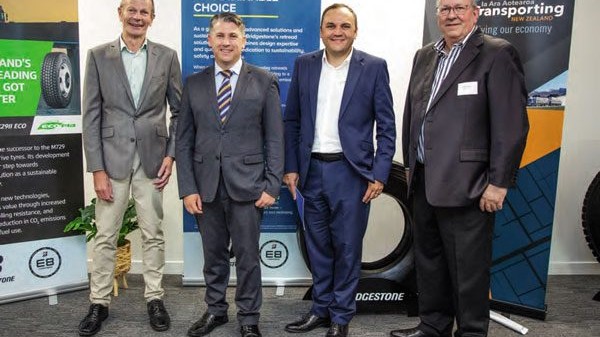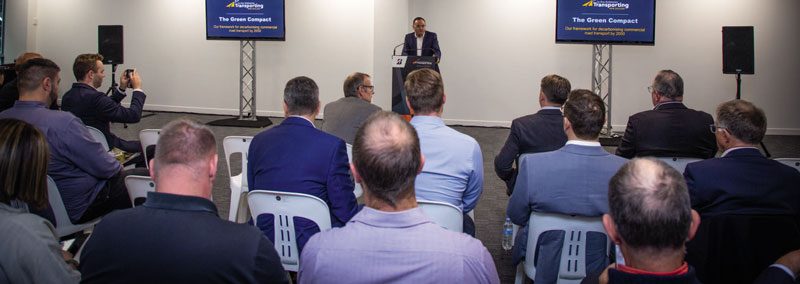Working towards a green future

Transporting NZ has launched a Green Compact with the IRU and Bridgestone NZ. The compact is the association’s long-term roadmap for decarbonising commercial road transport by 2050. As a framework document, it commits the industry to responsible emissions reduction and efficiencies while guiding it step by step.
As the world moves forwards in its fight against climate change and the pursuit of reduced emissions, all ‘cogs in the machine’ need to come together to contribute to the greater effort. It’s not a pursuit that can be left to legislators alone, with the private sector needing clear direction and commitment to do its part.
With this in mind, Transporting New Zealand launched the Green Compact to align with global industry efforts to increase efficiencies and reduce emissions. It will help guide engagement with government stakeholders on climate and show all stakeholders how to develop, adopt and roll out new technologies and ways of working.
The Green Compact framework has been adopted from the International Road Transport Union (IRU). The IRU, supported by Transporting New Zealand, is now undertaking a three-year work programme to evidence test and implement the Green Compact, which began in 2022. The focus for 2023 is identifying and collating a good base of evidence to support effective policy action.

The problem
According to the association, transport is responsible for 17% of New Zealand’s gross greenhouse gas (GHG) emissions and 39% of total domestic CO2 emissions. With more than 161,000 trucks on the road, 24.8% of those transport GHG emissions are produced by heavy vehicles weighing more than 3500kg GVW.
It adds that the Ministry of Transport projects that GHG emissions from the truck fleet in New Zealand will peak between 2025 and 2031. However, without significant policy and industry interventions, road freight could still contribute up to 2255 kilotonnes of GHG emissions by 2055. New Zealand’s freight task is projected to increase over the next 20 years to 366 million tonnes, the majority of that met by road.
The approach
The Green Compact is based on six decarbonisation pillars, each with its own objective and deliverables. These are: alternative fuels, efficient logistics, collective mobility, vehicle technologies, driver training and green infrastructure.
While five of these pillars were adopted from the IRU, Transporting New Zealand added ‘designing infrastructure to lessen emissions’ to reflect New Zealand’s roading and political environment.
Transporting New Zealand chief executive Nick Leggett says the industry is already making progress in many of these areas. “All six pillars represent practical transition that can already be implemented. We need to seize the low-hanging fruit while preparing for significant developments in the medium to long term.”
As part of the three-year work programme, a research report is being produced for each pillar to identify effective decarbonisation solutions. As such, the compact is expected to evolve.
Working together
Umberto de Pretto, secretary general of the IRU, sets the scene: “The road transport industry’s greatest challenge is to decarbonise while at the same time continue to keep logistics and mobility networks running efficiently for the communities and businesses we serve. With pragmatism, and the public and private sectors working together, we can decarbonise our fleets and keep delivering on road transport’s social and economic benefits in all countries.”
At the launch event, Leggett said that what the industry did for itself made a difference. “It’s up to us to act in the here and now, not wait passively for regulation or technology to determine the future. In New Zealand, we must adjust not only our ways of working and living, but also our resilience to withstand extreme climate events. The challenge is more urgent today.”
John Staples, director of New Zealand business at Bridgestone, said the company was taking a holistic approach, supporting customers to be more efficient, connected, productive and meet their sustainability objectives. “We feel it’s essential to be a part of initiatives like this so we can innovate in our own business to support the change within the industry. Sometimes it feels like what to do next is unknown, so the Green Compact implementation pathway is key to defining and supporting meaningful change for the industry.”
Transport Minister Michael Wood said the public and private sectors needed to draw on each other’s strengths. “Government doesn’t have all the levers. We know we can make a difference when we have collective purpose and the right policies. Our country is reliant on the road transport fleet, but the proportion of emissions from the heavy fleet will continue to grow as we reduce those from the light fleet. There’s real work to be done.”
Representing EECA, Richard Briggs commented that transport contributed nearly 20% of New Zealand’s gross domestic emissions, and transport emissions had increased by 90% since 1990. “We must create efficiency in the operations we’re running today. EECA will actively provide our support – we really need to incorporate your members’ ongoing feedback to understand the barriers better so we can create partnerships and move forward with decarbonising our sector.”
Read more
Feeding the talent pool
0 Comments9 Minutes
Pictures tell it all
0 Comments3 Minutes





